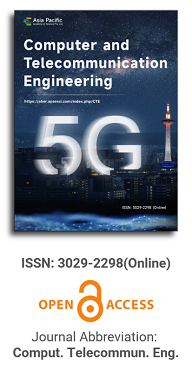
Fine-tuned large language models into traditional back-end web architectures
Vol 3, Issue 1, 2025
Download PDF
Abstract
Integrating Large Language Models (LLMs) into traditional back-end systems can significantly reduce development overhead and enhance flexibility. This paper presents a novel approach using a fine-tuned LLama3 model as a modular back-end component capable of processing JSON-formatted inputs and outputs. We developed a specialized dataset through advanced prompt engineering with the Phi-3.5 model and fine-tuned LLama3 using Quantized Low-Rank Adaptation (QLoRA) on a single NVIDIA T4 GPU. An API layer was designed to facilitate seamless communication between clients and the LLM, effectively replacing conventional application logic. Our fine-tuned model achieved an average accuracy of 76.5¥% and a response time of 3.56 s across 100 test cases, demonstrating its effectiveness in handling back-end tasks. This work underscores the potential of LLMs to transform AI-driven back-end architectures, offering scalable and efficient solutions for modern web services.
Keywords
References
- RoX818. How to Curate Datasets for OpenAI Fine-Tuning Success. AI Competence. Available online: https://aicompetence.org/how-to-curate-datasets-for-openai-fine-tuning/ (accessed on 22 January 2025).
- Parthasarathy VB, Zafar A, Khan A, et al. The Ultimate Guide to Fine-Tuning LLMs from Basics to Breakthroughs: An Exhaustive Review of Technologies, Research, Best Practices, Applied Research Challenges and Opportunities. Available online: https://arxiv.org/html/2408.13296v1 (accessed on 15 October 2024).
- Song Y, Xiong W, Zhu D, et al. RestGPT: Connecting Large Language Models with Real-World RESTful APIs. Available online: https://arxiv.org/abs/2306.06624 (accessed on 15 October 2024)
- Wang L, Yang N, Huang X, et al. Large Search Model: Redefining Search Stack in the Era of LLMs. Available online: https://arxiv.org/abs/2310.14587 (accessed on 21 October 2024).
- Pandya K, Holia M. Automating Customer Service Using LangChain: Building Custom Open-Source GPT Chatbot for Organizations. Available online: https://arxiv.org/abs/2310.05421 (accessed on 21 October 2024).
- Papageorgiou G, Sarlis V, Maragoudakis M, et al. Enhancing E-Government Services Through State-of-the-Art, Modular, and Reproducible Architecture Over Large Language Models. Applied Sciences. 2024; 14(18): 8259. doi: 10.3390/app14188259.
- Lewis P, Oguz B, Rinott R, et al. Retrieval-Augmented Generation for Knowledge-Intensive NLP Tasks. Available online: https://arxiv.org/abs/2005.11401 (accessed on 21 October 2024).
- Aisuko. Diverse Calculation. Hugging Face. Available online: https://huggingface.co/datasets/aisuko/diverse_calculation. https://doi.org/10.57967/hf/3724 (accessed on 9 December 2024).
- Micost. simple_calculation. Hugging Face Datasets. Available online: https://huggingface.co/datasets/micost/simple_calculation (accessed on 14 December 2024).
- Abdin M, Jacobs SA, Awan AA, et al. Phi-3 Technical Report: A Highly Capable Language Model Locally on Your Phone. Available online: https://api.semanticscholar.org/CorpusID:269293048 (accessed on 8 December 2024).
- Micost. db_operate. Hugging Face Datasets. Available online: https://huggingface.co/datasets/micost/db_operate (accessed on 8 December 2024).
- Micost. Fine-tuning Llama 3 with Simple Calculation. Kaggle. Available online: https://www.kaggle.com/code/micost/fine-tuning-llama-3-with-simple-calculation (accessed on 8 December 2024).
- Llama Team, AI @ Meta. The Llama 3 Herd of Models. Available online: https://arxiv.org/abs/2407.21783 (accessed on 8 December 2024).
- Dettmers T, Pagnoni A, Holtzman A. QLoRA: Efficient Finetuning of Quantized LLMs. Available online: https://arxiv.org/abs/2305.14314 (accessed on 8 December 2024).
- Mathav Raj J, Kushala VM, Warrier H, et al. Fine Tuning LLM for Enterprise: Practical Guidelines and Recommendations. Available online: https://arxiv.org/abs/2404.10779 (accessed on 8 December 2024).
- Microsoft. Phi-3.5-mini-instruct. Hugging Face. Available online: https://huggingface.co/microsoft/Phi-3.5-mini-instruct (accessed on 8 December 2024).
Supporting Agencies
Copyright (c) 2025 Author(s)
License URL: https://creativecommons.org/licenses/by/4.0/

Prof. Maode Ma
Qatar University, Qatar
The field of computer and telecommunications engineering is rapidly advancing, with the following being some of the latest developments.
more
We are pleased to congratulate the first anniversiry of the journal of Computer and Telecommunication Engineering (CTE).
more
Owing to the tireless dedication of the editor-in-chief, editorial board members, and the in-house editorial team, we are proud to announce the successful online launch of the first issue of Computer and Telecommunication Engineering.
Asia Pacific Academy of Science Pte. Ltd. (APACSCI) specializes in international journal publishing. APACSCI adopts the open access publishing model and provides an important communication bridge for academic groups whose interest fields include engineering, technology, medicine, computer, mathematics, agriculture and forestry, and environment.


.jpg)

.jpg)
